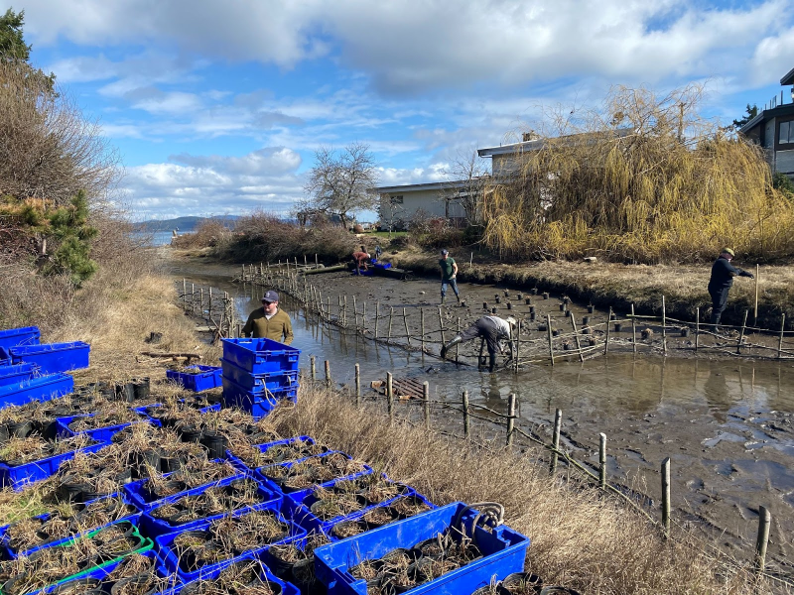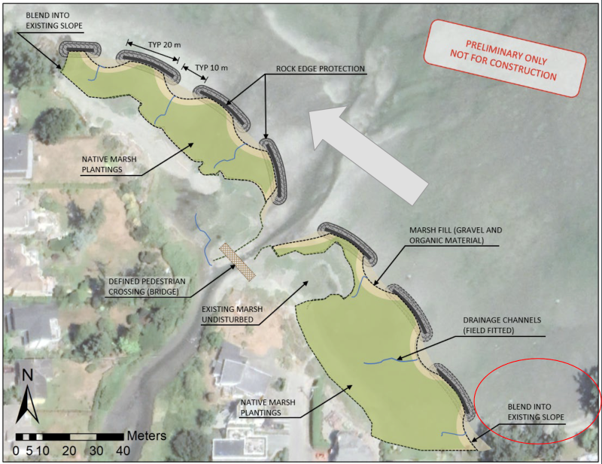Mermaid Creek Salt Marsh


Aerial images of Mermaid Creek delta, outlining salt marsh regression from 1964-2022. Over 70% of the marsh has been lost since 1960 and annual rates are increasing to upwards of 30% per year in the last two years.
The Mermaid Creek salt marsh is a small pickleweed (Salicornia pacifica) and salt grass (Distichlis spicata) dominated delta located at the mouth of Mermaid Creek on the southeast end of Roberts Bay, Sidney. This regionally rare coastal ecosystem is small but mighty in terms of its ecosystem productivity as well as provision of ecosystem services. Salt marshes provide blue carbon sequestration, important nutrients, water filtration, productive habitats for fish and wildlife, and natural protection for upland areas from strong storms through the buffering of wave energy.
These important coastal ecosystems are often the most desirable for agriculture, fishing and hunting, industrial practices, transportation infrastructure, habitation, and development. As a result of this, these ecosystems have been disproportionately lost, degraded, or modified over the past century—some estimates put this loss upwards of 70% in the Salish Sea. In 2021, PSS and SeaChange Marine Conservation Society commissioned Coastal and Ocean Resources Institute (CORI) to complete a Roberts Bay Blue Carbon Study. The report found that the Mermaid Creek salt marsh had experienced a significant decline of over 70% in the last 60 years. The past two years have seen a significant acceleration of erosion rates with ~30% of marsh area eroding annually.
To better understand the causes and dynamics of this erosion, and to provide a concept for a solution, we commissioned DHI to complete another report in 2022. The report provided a summary of wave conditions in Roberts Bay and highlighted several likely contributing factors to the decline of the Mermaid Creek salt marsh:
- The historical modification of natural sources and conduits of sediment being delivered to the marsh, both from Mermaid Creek itself as well as from the marine environment.
- Increased forces of erosion driven by climate change including intense storm surges and sea level rise.
Importantly, the burial and incorporation of Mermaid Creek into the Town of Sidney’s stormwater system cut off sediments delivered by Mermaid Creek to the delta. Additionally, modified shorelines, including hard armouring, disrupt the dynamic nature of coastal sediment processes including erosion, transport, and wave structure in the bay. The report concluded that if action is not taken, there is a large likelihood this important ecosystem and habitat will be lost with severe ecological consequence to Roberts Bay, including loss and diminishment of stormwater filtration, blue carbon sequestration, shoreline stabilization, sustainable beach nourishment, shoreline protection, pollination, aesthetic and cultural values, and productive habitats for fish and wildlife.
In 2022, PSS, SeaChange Marine Conservation Society, and Tseycum First Nation secured funding to deliver the much larger restorative concept provided by DHI and finalized by McElhanney that addresses the restoration of the lower salt marsh. This work was funded by Environment and Climate Change Canada, World Wildlife Fund, North America Partnership for Environmental Community Action, Real Estate Foundation of BC, Pacific Salmon Foundation, and the Town of Sidney.
Phase 1

Mermaid Creek eco-cultural fencing, completed September 2022 and subsequent planting March 2023. 500 Lyngbye’s sedges were planted throughout the upper marsh. This grass-like species actively builds the marsh by stilling water with its long vegetation allowing sediment to deposit which it then fixes with its roots, overtime rebuilding marsh banks.
Phase 1 focused on the upper marsh area of the Mermaid Creek estuary. To help retain the rapidly eroding banks and expand the upper portion of the marsh, eco-cultural fencing was installed on the banks of the creek in September 2022. PSS staff were joined by Roberts Bay Residents’ volunteers and the Guardians of Mid Island Estuaries Society to install alder and willow fencing to help stabilize eroded materials and protect Lyngbye's sedge out-plantings from Canada goose grazing which were planted by volunteers and members of Tseycum in March 2023.
Phase 2 — Cancelled
The remainder of the Mermaid Creek Salt Marsh Restoration Project was regrettably cancelled due to complications surrounding riparian property rights infringement. The decision came after extensive deliberation and consultation with the project's funders, partners, stakeholders, and regulators. For more information, see our press release here.
Restoration plans would have included:
- Creating 1 m high rock crescent clustered headlands 20 m seaward of the existing marsh edge to attenuate wave energy from intensifying storm surges.
- Nourishing the area between the existing marsh edge and the newly formed headlands with 4,000 tons of imported marsh and beach sediments.
- Planting and stabilizing the restored marsh area with pickleweed and salt grass.
- Adaptive management and monitoring of elevations, materials, and plantings.
This restoration would have increased and enhanced carbon sequestration capacity of the marsh, nature-based shoreline protection from projected increase in storm surges and sea level rise, and vital habitat for fish, birds, invertebrates, bivalves, and other wildlife.

